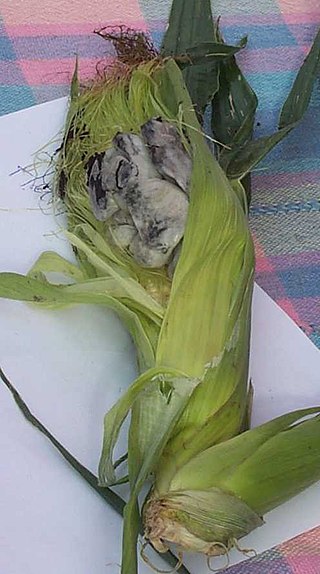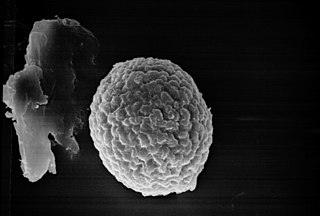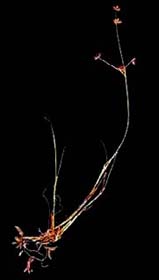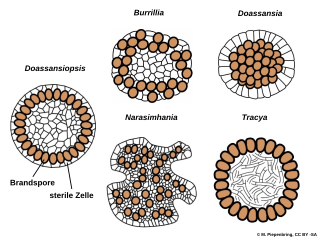
The smuts are multicellular fungi characterized by their large numbers of teliospores. The smuts get their name from a Germanic word for 'dirt' because of their dark, thick-walled, and dust-like teliospores. They are mostly Ustilaginomycetes and comprise seven of the 15 orders of the subphylum. Most described smuts belong to two orders, Ustilaginales and Tilletiales. The smuts are normally grouped with the other basidiomycetes because of their commonalities concerning sexual reproduction.

The Ustilaginales are an order of fungi within the class Ustilaginomycetes. The order contained 8 families, 49 genera, and 851 species in 2008.

The Ustilaginomycotina is a subdivision within the division Basidiomycota of the kingdom Fungi. It consists of the classes Ustilaginomycetes and Exobasidiomycetes, and in 2014 the subdivision was reclassified and the two additional classes Malasseziomycetes and Monilielliomycetes added. The name was first published by Doweld in 2001; Bauer and colleagues later published it in 2006 as an isonym. Ustilagomycotina and Agaricomycotina are considered to be sister groups, and they are in turn sister groups to the subdivision Pucciniomycotina.
Sporisorium sorghi, commonly known as sorghum smut, is a plant pathogen that belongs to the Ustilaginaceae family. This fungus is the causative agent of covered kernel smut disease and infects sorghum plants all around the world such as Sorghum bicolor (sorghum), S. sudanense, S. halepense and Sorghumvulgare var. technichum (broomcorn). Ineffective control of S. sorghi can have serious economic and ecological implications.
Thecaphora is a genus of basidiomycote fungus which contains several species of plant pathogens. The widespread genus contained about 57 species in 2008. and held 61 species in 2020.
The Doassansiales are an order of fungi in the class Exobasidiomycetes. The order consist of three families: the Doassansiaceae, the Melaniellaceae, and the Rhamphosporaceae.

The Tilletiales are an order of smut fungi in the class Exobasidiomycetes. It is a monotypic order, consisting of a single family, the Tilletiaceae, which contains seven genera. The roughly 150 species in the Tilletiales all infect hosts of the grass family, except for species of Erratomyces, which occur on legumes.

Entorrhizomycetes is the sole class in the phylum Entorrhizomycota, within the Fungi subkingdom Dikarya along with Basidiomycota and Ascomycota. It contains three genera and is a small group of teliosporic root parasites that form galls on plants in the Juncaceae (rush) and Cyperaceae (sedge) families. Prior to 2015 this phylum was placed under the subdivision Ustilaginomycotina. A 2015 study did a "comprehensive five-gene analyses" of Entorrhiza and concluded that the former class Entorrhizomycetes is possibly either a close sister group to the rest of Dikarya or Basidiomycota.

Pucciniomycetes is a diverse class of fungi in the subphylum Pucciniomycotina of phylum Basidiomycota. The class contains 5 orders, 21 families, 190 genera, and approximately 8,016 species. It has been estimated that this class contains about one third of all teleomorphic basidiomycetes. Pucciniomycetes contains many economically important plant pathogenic fungal rusts; the order Pucciniales is the largest clade in this class, representing approximately 7,000 species.

The Ustilaginaceae are a family of smut fungi in the order Ustilaginomycetes. Collectively, the family contains 17 genera and 607 species.

The Anthracoideaceae are a family of smut fungi in the order Ustilaginales. Collectively, the family contains 20 genera and 198 species. Anthracoideaceae was circumscribed by the Bulgarian mycologist Cvetomir M. Denchev in 1997.
The Melanotaeniaceae are a family of smut fungi in the order Ustilaginomycetes, containing three genera.
The Exoteliospora is a monotypic, genus of smut fungi in the family Melanotaeniaceae which contains the single species Exoteliospora osmundae.
The Melanotaenium is a genus of smut fungi in the family Melanotaeniaceae.

Kálmán Géza Vánky was a Hungarian mycologist with Swedish and Hungarian citizenship, who lived in Germany. He was considered to be the worldwide authority on the subject of smut fungi and has dominated the taxonomic study of Ustilaginomycetes for at least the past four decades.
Robert Bauer was a German mycologist, specialising in rust (Uredinales) and smut (Ustilaginomycetes) fungi.

Doassansiopsis is a genus of smut fungi belonging to the monotypic family DoassansiopsidaceaeBegerow, R.Bauer & Oberw., 1998, within the class Ustilaginomycetes and order Urocystidales.

The Urocystidales are an order of fungi within the class Ustilaginomycetes. The order contains 6 families and about 400 genera. They are a sister order to Ustilaginales.

The Doassansiaceae are a family of fungi in the division Basidiomycota and order of Doassansiales. The family contains 11 genera and about 58 species. They have a widespread distribution. Doassansiaceae is also known and classified as a smut fungi.

The Rhamphosporaceae is a family of fungi in the division Basidiomycota and order of Doassansiales. The monotypic family only contains 1 genus; RhamphosporaD.D.Cunn. and just 1 species, Rhamphospora nymphaeaeD.D.Cunn. It is found on the leaves of waterlilies causing spots.











